Ex: http://www.europemaxima.com
Europe Maxima met en ligne la conférence de Georges Feltin-Tracol prononcée le 17 mai 2014 à Lyon dans le cadre du colloque « Réflexions à l’Est » à l’invitation de l’association Terre & Peuple.
Mesdames, Mesdemoiselles, Messieurs, Chers Amis,
Avec les développements inquiétants de la crise ukrainienne, la presse officielle de l’Hexagone insiste lourdement sur l’influence, réelle ou supposée, d’Alexandre Douguine, le théoricien russe du néo-eurasisme, sur les gouvernants russes. Ainsi, Bruno Tertrais l’évoque-t-il dans Le Figaro du 25 avril 2014. Puis c’est au tour du quotidien Libération du 28 avril d’y faire référence. Toujours dans Le Figaro, mais du 20 avril, c’est la philosophe catholique, libérale et néo-conservatrice Chantal Delsol de le citer… mal. Mieux, Le Nouvel Observateur du 1er mai lui consacre quatre pages sous la signature de Vincent Jauvert qui le qualifie de « Raspoutine de Poutine ». Même la livraison mensuelle de mai du Monde diplomatique en vient à traiter de l’eurasisme (1).
Cette notoriété médiatique tranche avec leur discrétion habituelle sur le sujet. Jusqu’à ces dernières semaines, et à part les périodiques de notre large mouvance rebelle, Alexandre Douguine était parfois évoqué par les correspondants permanents du journal Le Monde à Moscou (2). Certes, si ses œuvres complètes ne sont pas accessibles aux lecteurs francophones, ceux-ci disposent néanmoins de quelques ouvrages et textes essentiels traduits (3).
L’engouement des plumitifs du Système altantique-occidental pour le penseur polyglotte du néo-eurasisme témoigne en tout cas de l’intérêt qu’on porte à ses idées. Plus largement, la question de l’Eurasie suscite une réelle curiosité. Outre le n° 59 du magazine Terre et Peuple de ce printemps 2014, signalons que le dossier du nouveau trimestriel de géopolitique animé par Pascal Gauchon, Conflits, concerne « L’Eurasie. Le grand dessein de Poutine ».
Fins connaisseurs des thèses eurasistes, les rédacteurs du Terre et Peuple n° 59 préfèrent pour leur part se rallier à la thèse de l’Eurosibérie. De quoi s’agit-il donc ? C’est en 1998, soit plus d’une dizaine d’années après avoir quitté la métapolitique, que Guillaume Faye y revient avec un essai magistral, L’archéofuturisme. Cet ouvrage qui fit date dans nos milieux, bouscule maintes certitudes tenaces et balance quelques bombes idéologiques dont le fameux concept d’Eurosibérie. Guillaume Faye écrivait qu’« il faudra bien un jour intégrer la Russie et envisager l’avenir sous les traits de l’Eurosibérie. Les déboires actuels de la Russie ne sont que d’ordre transitoire et conjoncturel. Il s’agit simplement de contrer la (naturelle et explicable) volonté des États-Unis de contrôler l’Eurosibérie et de placer la Russie sous un protectorat et une assistance financière, prélude à sa vassalisation stratégique et économique (4) ».
Le concept d’Eurosibérie se réfère explicitement à la « Maison commune » du Soviétique Mikhaïl Gorbatchev exprimée en juillet 1989, et de la « Confédération européenne » esquissée le 31 décembre 1989 par François Mitterrand (5) avant que ces deux projets soient torpillés par les nouveaux agents de l’atlantisme en Europe centrale et orientale parmi lesquels le déplorable théâtreux tchèque Vaclav Havel.
L’Eurosibérie correspond à un espace géographique déterminé. « Notre frontière est sur l’Amour. Face à la Chine. Sur l’Atlantique et le Pacifique, face à la république impériale américaine, unique super-puissance mais dont le déclin géostratégique et culturel est déjà “ viralement ” programmé pour le premier quart du XXIe siècle – dixit Zbigniew Brzezinski, pourtant apologiste de la puissance américaine. Et, sur la Méditerranée et le Caucase, face au bloc musulman (moins divisé qu’on ne le pense) qui ne nous fera surtout jamais de cadeaux et peut constituer la première source de menaces mais aussi, si nous sommes forts, un excellent partenaire… (6) » Alors, éventuellement, « demain, poursuit Faye : de la rade de Brest à celle de Port-Arthur, de nos îles gelées de l’Arctique au soleil victorieux de la Crète, de la lande à la steppe et des fjords au maquis, cent nations libres et unies, regroupées en Empire, pourront peut-être s’octroyer ce que Tacite nommait le Règne de la Terre, Orbis Terræ Regnum (7) ».
En lisant L’archéofuturisme, on remarque que Guillaume Faye écarte la notion même d’Occident. Rappelons qu’il fut l’un des premiers en 1980 à dissocier et à opposer l’Occident – dominé par Washington -, de l’Europe dont nous sommes les paladins (8). Préoccupé par la montée démographique rapide des peuples du Sud, Faye imagine l’Eurosibérie intégrer une « solidarité globale – ethnique, fondamentalement – du Nord face à la menace du Sud. Quoi qu’il en soit, la notion d’Occident disparaît pour céder la place à celle du Monde du Nord, ou Septentrion (9) ». Après l’avoir combattu (10), il se rallie en fin de compte à l’avis de Jean Cau. Parce que « nous ne pouvons pas compter sur les États-Unis pour s’opposer à un mondialisme dont le monde-race blanc ferait seul les frais (11) », son célèbre Discours de la décadence n’excluait pas « ce qui me paraît essentiel pour notre salut : un nationalisme (et donc par là même un refus du mondialisme) qui, quelles que soient les rigueurs qu’il implique et les répugnances qu’il peut inspirer aux décadents que nous sommes (et qui ont lié les idées de liberté à la réalisation de ce mondialisme en lequel elles n’auront plus de contenu et de sens) est notre seul possible Destin (12) ». En effet, « par son action, continue Jean Cau, la Russie a plus le souci de défendre son empire que de “ libérer ” les peuples. C’est en vertu d’une vocation impériale, afin de rester intacte et non par idéalisme moralisant et mondialiste qu’elle agit (13) ». « Telle est, en ces années 70 – et bientôt 80 – ma “ vue de l’esprit ”, poursuit-il. Ô paradoxe n’est-ce pas, que de déclarer qu’une Russie nationale, de par sa résistance à l’Américanisme mondialiste, est peut-être la seule chance de nos nations et de notre monde-race blanc ? Paradoxe apparent, je le crains. Et vérité d’Histoire, je le crois (14). »
Dans Pourquoi nous combattons, publié en 2001, Guillaume Faye revient sur l’Eurosibérie qu’il définit comme un exemple d’« ethnosphère (15) ». Bloc continental à l’économie auto-centrée, c’« est l’espace destinal des peuples européens enfin regroupés, de l’Atlantique au Pacifique, scellant l’alliance historique de l’Europe péninsulaire, de l’Europe centrale et de la Russie (16) ». Il s’agit, dans son esprit, d’une « forteresse commune, la maison commune, l’extension maximale et l’expression naturelle de la notion d’« Empire européen ». Elle serait véritablement la “ Troisième Rome ”, ce que ne fut jamais la Russie (17) ».
Relevons en revanche l’absence dans ce manifeste du Septentrion. Est-ce parce qu’en 1989, on évoquait déjà une communauté euro-atlantique de Vancouver à Vladivostok ? Le 25 septembre 2001, Vladimir Poutine s’adressa en allemand au Bundestag. Il voyait alors la Russie comme un pays européen et occidental. C’était le temps où Moscou tentât d’adhérer à l’Alliance Atlantique. Aux États-Unis, certains cénacles de pensée stratégique proches des paléo-conservateurs, ces adversaires farouches du néo-conservatisme, approuvaient cette démarche destinée in fine à contrer l’ascension chinoise. L’auteur de thriller-fictions, Tom Clancy, en fit un roman, L’Ours et le Dragon (18). Une approche assez similaire se retrouve chez l’écrivain Maurice G. Dantec dans les trois volumes de son Journal métaphysique et polémique. Ainsi écrit-il dans Laboratoire de catastrophe générale que « l’O.T.A.N. doit donc non seulement intégrer au plus vite toutes les anciennes républiques populaires de l’Est européen, mais prévoir à moyen terme une organisation tripartite unifiant les trois grandes puissances boréales : Amérique du Nord, Europe Unie (quel que soit son état, malheureusement) et Russie, plus le Japon, au sein d’un nouveau traité Atlantique – Pacifique Nord, qui puisse faire contrepoids à l’abomination onuzie et aux menaces sino-wahhabites. […] La seule issue pour l’Occident est donc bien de définir un nouvel arc stratégique panocéanique, trinitaire, avec l’Amérique au centre, l’Europe du côté atlantique, et la Fédération de Russie, assistée du Japon, pour l’espace pacifique – sibérien (19) ».
Dénoncé par le national-républicain Régis Debray (20), l’option pan-occidentaliste a trouvé en Maurice G. Dantec son chantre décomplexé. Toutefois, à part l’implication du Japon, le cadre pan-occidental (ou Hyper-Occident) correspond déjà à l’O.C.D.E. (Organisation de coopération et de développement économique) et à l’O.S.C.E. (Organisation pour la sécurité et la coopération en Europe). « Issue en 1994 de la transformation de la Conférence sur la sécurité et la coopération en Europe d’Helsinki (1975), note Jean-Sylvestre Mongrenier, l’O.S.C.E. est une organisation régionale de sécurité juridiquement reliée à l’O.N.U. Ce forum regroupe les États d’Europe (Russie comprise), d’Asie centrale (les anciennes républiques musulmanes d’U.R.S.S.) et d’Amérique du Nord, soit 51 États membres. L’O.S.C.E. est tournée vers la maîtrise des armements et la diplomatie préventive (21). » Aujourd’hui, l’O.S.C.E. compte 57 membres ainsi que six partenaires méditerranéens pour la coopération (Algérie, Égypte, Israël, Jordanie, Maroc, Tunisie), et cinq partenaires asiatiques (Japon, Corée du Sud, Thaïlande, Afghanistan et Australie). Par ailleurs, l’orientation nord-hémisphérique que préfigure imparfaitement l’O.S.C.E., ne se confine pas au seul cénacle littéraire. « J’ai aussi été l’un des tout premiers, à l’époque de l’effondrement soviétique, à lancer l’idée de la construction politique d’un “ continent boréal ”, de Brest à Vladivostok, affirme Jean-Marie Le Pen (22). » En 2007, son programme présidentiel mentionnait de manière explicite une « sphère boréale » de Brest à Vladivostok.
Dans son dernier tome du Journal métaphysique et polémique, Maurice G. Dantec, converti, suite à ses lectures patristiques et philosophiques, au catholicisme traditionaliste, vomit l’Union européenne, l’O.N.U., le multiculturalisme, et en appelle à l’avènement d’« États continentaux – fédéraux, vagues souvenirs des empires d’autrefois (23) ». Exigeant une « Grande Politique » pour le pâle mécanisme européen qu’il surnomme « Zéropa-Land », il croit toutefois que « véritable fondation politique du continent, car seule capable historiquement de fonder quelque chose, l’O.T.A.N., ce vénérable Anneau de Pouvoir, est seule habilitée à le refondre. Elle va s’auto-organiser dans le développement tri-polaire de l’Occident futur : Russie/Europe de l’Est – Grande-Bretagne + Commonwealth – Amérique hémisphérique (24) ». Enthousiasmé par l’American way of life, l’auteur de Babylon Babies prétend que « les Américains, sous peu, auront encore plus besoin des Russes que ceux-ci des Américains; un peu comme avec la Deuxième Guerre mondiale, la Quatrième Guerre mondiale, qui est le régime international – pacifié de la guerre comme continuation du terrorisme par d’autres moyens, va fournir le décor pour un basculement d’alliance stratégique comme jamais il n’y eut dans l’histoire des hommes. Le dollar U.S. intronisé monnaie en Sibérie. Les ressources humaines et naturelles de la Russie, les ressources humaines et financières des États-Unis. À elles deux, ces deux nations l’ont montré, elles seraient capables de mettre en place un véritable condominium planétaire, basé sur les technologies de la conquête spatiale et un partage des responsabilités qui équivaudraient à une win-win situation, comme aiment le dire ces salauds de capitalistes yankees (25) ». Acquis à l’Occident génétiquement survitaminé, Dantec balaie sans aucune hésitation toute Eurosibérie possible. « Poutine devrait y réfléchir à deux fois avant de s’engager avec les Franco-boches, contre le Nouvel Occident, avertit Dantec. Malgré les délires de certains “ penseurs ” de la “ droite révolutionnaire ”, les Sibériens n’ont strictement rien à battre des pantins qui s’agitent à Strasbourg ou à Bruxelles, c’est-à-dire à leurs antipodes sur tous les plans. Quand je lis, de-ci de-là, de telles avanies sur une sorte de bloc euro-continental qui s’étendrait de Paris – Ville lumière jusqu’à Vladivostok, et sous le nom d’Europe, rien ne peut retenir mon rire d’éclater à la face de ces bidules prophétologiques dérisoires, et même pas vraiment criminels. Imaginent-ils donc qu’un marin russe qui pêche dans les eaux du Kamtchatka puisse se sentir en quelque façon “ européen ”, à quelques encablures du Japon? Anchorage sera toujours plus près d’Irkoutsk que n’importe laquelle des capitales de l’union franco-boche (26). »
Bien que réfractaire au concept eurosibérien, Dantec n’en demeure pas moins le défenseur d’un monde – race blanc, d’un Septentrion sous une forme déviante et identitairement inacceptable. D’autres font le même constat mais en lui donnant une formulation plus convaincante. Co-fondateur du site Europe Maxima, mon camarade et vieux complice Rodolphe Badinand promeut un Saint-Empire européen arctique. « La maîtrise du pôle Nord est une nécessité géopolitique et mythique, note-t-il. Outre qu’il est impératif que l’Empire s’assure du foyer originel de nos ancêtres hyperboréens, le contrôle du cercle polaire revêt une grande valeur stratégique. Si le réchauffement planétaire se poursuit et s’accentue, dans quelques centaines d’années, la banquise aura peut-être presque disparu, faisant de l’océan polaire, un domaine maritime de toute première importance. En s’étendant sur les littoraux des trois continents qui la bordent, le Saint-Empire européen arctique, dans sa superficie idéale qui comprendrait […] l’Eurosibérie et les territoires septentrionaux de l’Amérique du Nord (Alaska, Yukon, Territoire du Nord-Ouest, Nunavut, Québec, Labrador, Terre-Neuve, Acadie, Provinces maritimes de l’Atlantique), le Groenland et l’Islande, détiendrait un atout appréciable dans le jeu des puissances mondiales. C’est enfin la transposition tangible dans l’espace du symbole polaire. Comme l’Empereur est la référence de l’Empire, notre Empire redeviendra le pôle du monde, le référent des renaissances spirituelles et identitaires de tous les peuples, loin de tout universalisme et de tout mondialisme (27). »
Guillaume Faye, Jean Cau, Maurice G. Dantec, Rodolphe Badinand réfléchissent au fait politique à partir du critère géographique de grand espace. Ils poursuivent, consciemment ou non, les travaux du philosophe euro-américain Francis Parker Yockey (28), du géopoliticien allemand Karl Haushofer et du théoricien géopolitique belge Jean Thiriart (29). Dès la décennie 1960, ce dernier pense à un État-nation continental grand-européen qui s’étendrait de Brest à Vladivostok. Puis, au fil du temps et en fonction des soubresauts propres aux relations internationales, il en vient à soutenir dans les années 1980 un empire euro-soviétique. La fin de l’U.R.S.S. en 1991 ne l’empêche pas d’envisager une nouvelle orientation géopolitique paneuropéenne totale. Influencé, au soir de sa vie, par son compatriote Luc Michel, Jean Thiriart suggère « une République impériale allant de Dublin à Vladivostok dans les structures d’un État unitaire, centralisé (30) ». Le fondement juridique de cet État grand-européen reposerait sur l’« omnicitoyenneté ». « Né à Malaga, diplômé à Paris, médecin à Kiev, plus tard bourgmestre à Athènes le seul et même homme jouira de tous les droits politiques à n’importe quel endroit de la République unitaire (31). » Mais quelles frontières pour cet espace politique commun ? « Les limites territoriales vitales de l’Europe “ Grande Nation ”, écrit Thiriart, vont ou passent à l’Ouest de l’Islande jusqu’à Vladivostok, de Stockholm jusqu’au Sahara-Sud, des Canaries au Kamtchaka, de l’Écosse au Béloutchistan. […] L’Europe sans le contrôle des deux rives à Gibraltar et à Istanbul traduirait un concept aussi risible et dangereux que les États-Unis sans le contrôle de Panama et des Malouines. Il nous faut des rivages faciles à défendre : Océan glacial Arctique, Atlantique, Sahara (rivage terrestre), accès aux détroits indispensables, Gibraltar, Suez, Istanbul, Aden – Djibouti, Ormuz (32). » La Grande Europe selon Thiriart intègre non seulement l’Afrique du Nord, mais aussi la Turquie, le Proche-Orient et l’Asie Centrale, Pakistan inclus ! La capitale de cette Méga-Europe serait… Istanbul !
On doit reconnaître que les thèses exposées ici dépassent largement ce que François Thual et Aymeric Chauprade désignent comme des « panismes ». « On appelle panisme, ou pan-idée, une représentation géopolitique fondée sur une communauté d’ordre ethnique, religieuse, régionale ou continentale. Le “ ou ” ici n’étant pas exclusif. Le concept forgé dès les années 1930 par la géopolitique allemande de Karl Haushofer sous le vocable Pan-Idee, est repris et développé par François Thual dans les années 1990 (33). »
Nonobstant l’inclusion de l’Afrique du Nord dans l’aire politique grande-européenne, l’ultime vision de Jean Thiriart correspond imparfaitement à l’eurasisme dont Alexandre Douguine est l’une des figures les plus connues. Or la réflexion eurasiste ne se réduit pas à cette seule personnalité.
Pour faire simple et court, car il ne s’agit pas de retracer ici la généalogie et le développement tant historique qu’actuel de l’eurasisme (34), ce courant novateur résulte, d’une part, du panslavisme, et, d’autre part, du slavophilisme. Inventé à la Renaissance par un Croate, Vinko Pribojevitch, le panslavisme entend restaurer l’unité politique des peuples slaves à partir de leur héritage historique et linguistique commun retracé par des philologues et des poètes. Le panslavisme se politise vite. En 1823 – 1825 existe en Russie une Société des Slaves unis liée au mouvement libéral décabriste. Contrairement à ses prolongements ultérieurs, le premier panslavisme est plutôt libéral, voire révolutionnaire – l’anarchiste Michel Bakounine participe en 1848 au Ire Congrès panslave à Prague. Cette réunion internationale en plein « Printemps des Peuples » est un échec du fait de son éclatement en trois tendances antagonistes :
— un courant libéral et démocratique représenté par la Société démocratique polonaise, fondée en 1832, qui s’oppose surtout aux menées russes et veut rassembler les Slaves de l’Ouest catholiques romains ou réformés;
— une tendance plus attachée à la foi orthodoxe et donc plus alignée sur la Russie impériale, qui agite les Slaves du Sud (Monténégrins, Serbes, Macédoniens, Bulgares) vivant dans des Balkans soumis au joug ottoman et qui rêve d’une libération nationale grâce à l’intervention de Saint-Pétersbourg, le seul État slave-orthodoxe indépendant (c’est le « russo-slavisme »);
— une faction austro-slaviste prônée par des Tchèques, des Polonais de Galicie, des Slovaques et des Croates qui essaye de fédérer des Slaves de l’Ouest, des Balkans et de l’espace danubien sous l’autorité des Habsbourg.
La postérité du panslavisme dans la seconde moitié du XIXe siècle suit des prolongements inattendus. Le « russo-slavisme » vire en un « pan-orthodoxisme » impérialiste qui n’hésite pas à exclure Polonais et Tchèques jugés trop occidentaux et « romano-germains » quand il ne les russifie pas. Encouragé par de brillants publicistes dont le Russe Nicolas Danilevski, ces panslavistes pro-russes approuvent la guerre russo-turque de 1877 – 1878 dont la victoire militaire russe se solde au Congrès de Berlin en défaite diplomatique à l’initiative des puissances occidentales.
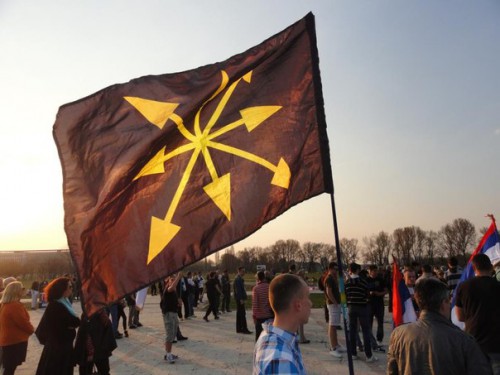
Opposé à la présence russe, les panslavistes polonais évoluent vers des positions nationalistes plus ou moins affirmées. La Démocratie nationale de Dmovski œuvre avant 1914 pour un royaume de Pologne en union personnelle avec le tsar tandis que le militant socialiste et futur maréchal polonais, Joseph Pilsudski, récuse toute collaboration avec la Russie. Ayant en tête l’âge d’or de l’Union de Pologne – Lituanie entre les XIVe et XVIIIe siècles, ce Polonais natif de la ville lituanienne de Vilnius envisage un glacis anti-russe de la Baltique à la Mer Noire, soit la Pologne, la Lituanie, la Biélorussie et l’Ukraine : la Fédération Intermarum ou Fédération Entre Mers. Cette aspiration fédéraliste demeurera le cœur nucléaire du prométhéisme de Pilsudski. Ce projet de Fédération Entre Mers (avec les États baltes) vient de réapparaître dans le programme électoral présidentiel du mouvement ultra-nationaliste ukrainien Pravyï Sektor (Secteur droit) de Dmytro Yaroch (35).
Le conservatisme de la Double-Monarchie déçoit l’austro-slavisme qui laisse bientôt la place à des panismes partiels (ou panslavismes régionaux). En 1914, la Serbie encourage l’irrédentisme des Serbes de Bosnie au nom du yougoslavisme. Mais ce yougoslavisme, orthodoxe et russophile, à forte tonalité panserbe, diffère tant du yougoslavisme de l’archevêque croate Joseph Strossmayer qui souhaite rassembler autour des Habsbourg les peuples slaves du Sud que du yougoslavisme libertaire et socialiste favorable à une large fédération balkanique, concrétisé en août 1903 par l’éphémère république socialiste macédonienne de Kroutchevo. On sait que l’archiduc François-Ferdinand, époux d’une aristocrate tchèque, préconisait une Triple-Monarchie avec un pilier slave, ce que ne voulaient pas les Hongrois d’où peut-être une connivence objective entre certains services serbes et quelques milieux républicains magyars…
Faut-il pour autant parler du naufrage du panslavisme ? Sûrement pas quand on examine la politique étrangère de l’excellent président du Bélarus, Alexandre Loukachenko. Depuis 1994, date de l’arrivée au pouvoir de cet authentique homme d’État dont l’action contraste avec la nullité des Cameron, Merkel, l’« Écouté de Neuilly » ou notre Flamby hexagonal !, le président bélarussien a à plusieurs reprises encouragé le renouveau panslaviste. Permettez-moi par conséquent de m’inscrire ici en faux avec l’affirmation d’Alain Cagnat qui qualifie le Bélarus de « musée du stalinisme. [… Cet État] n’a aucune existence internationale. Quant au pseudo-particularisme linguistique ou culturel biélorusse, cela tient au folklore. On peut logiquement penser que, une fois refermée la parenthèse Loukachenko, les Biélorussiens se hâteront de rejoindre le giron russe (36) ». Que le russe soit depuis 1995 la langue co-officielle du Bélarus à côté du bélarussien n’implique pas nécessairement une intégration future dans la Russie sinon les Irlandais, tous anglophones, demanderaient à rejoindre non pas la Grande-Bretagne (ils ont largement donné), mais plutôt les États-Unis, ou bien les Jurassiens suisses la République française. La présidence d’Alexandre Loukachenko a consolidé l’identité nationale bélarussienne qui s’enracine à la fois dans les traditions polythéistes slaves et l’héritage chrétien. Lors du solstice d’été, le Bélarus célèbre la fête de Yanka Koupali. Ce rite très ancien témoigne de l’attachement de la population à ses racines ainsi qu’à la nature. Il s’agit d’invoquer les éléments naturels pour que les récoltes soient bonnes. De nombreuses danses folkloriques sont alors exécutées par des jeunes femmes aux têtes couronnées de fleurs.
Par ailleurs, membre du Mouvement des non-alignés et allié du Venezuela de feu le Commandante Hugo Chavez, le Bélarus se trouve à l’avant-garde de la résistance au Nouveau désordre mondial propagé par l’Occident américanomorphe. Les projets d’union Russie – Bélarus sont pour l’heure gelés. Pour s’unir, il faut un consentement mutuel. Or le peuple bélarussien se sent autre par rapport à ses cousins russes. La revue en ligne, Le Courrier de la Russie, rapporte une certaine méfiance générale envers le grand voisin oriental. Une esthéticienne de Minsk déclare au journaliste russe : « Si la Russie et la Biélorussie se réunissent, ce sera du grand n’importe quoi. En Biélorussie, il y a de la discipline et de l’ordre, mais en Russie, il y a trop d’injustice, c’est le désordre (37). » Quelques peu dépités par les témoignages recueillis, les auteurs de l’article soulignent finalement que « pour les Biélorusses, la langue russe n’est pas associée directement avec la Russie », que « la Russie est perçue plutôt comme une force politique, du reste à l’esprit impérial assez désagréable » et quand « nous avons proposé à des étudiants de passer une sorte de test projectif – dessiner leur pays sur la carte du monde en s’orientant non sur les connaissances géographiques mais sur les associations personnelles, la majorité des Biélorusses ont fourni une image très semblable. Leur pays au centre et, autour, comme des pétales de marguerite et avec une importance équivalente, la Russie, la Pologne, la Lituanie, le Venezuela… (38) »
Sur la crise ukrainienne, le Président Loukachenko rejette toute fédéralisation du pays. Il a aussi reconnu et reçu le gouvernement provisoire de Kyiv et condamne les tentatives de sécession. Déjà en 2008, ce fidèle allié de Moscou n’a jamais reconnu l’indépendance de l’Abkhazie et de l’Ossétie du Sud. Mieux, il n’hésite pas à contrarier les intérêts russes. Le 26 août 2013, un proche de Poutine, Vladislav Baumgertner, directeur général d’Uralkali, une importante firme russe spécialisée dans la potasse, est arrêté à Minsk et incarcéré. « Quels que soient les sentiments qu’il inspire, le président biélorusse Alexandre Loukachenko entretient avec le Kremlin des relations qui sont plus d’égal à égal que celles des Grecs avec Merkel : imaginez ce qui se passerait si le patron d’une grosse entreprise allemande était arrêté en Grèce (39). » Minsk peut donc se montrer indocile envers Moscou qui respecte bien plus que les donneurs de leçons occidentaux la souveraineté étatique. En outre, contrairement encore à l’État-continent, le Bélarus n’appartient pas à l’O.M.C. et applique encore la peine de mort.
À la fin des années 1830 apparaissent en Russie les slavophiles (Alexis Khomiakov, Constantin Léontiev, Ivan Kireïevski, Constantin Aksakov, Fiodor Dostoïevski, etc.) dont la dénomination était à l’origine un sobriquet donné par leurs adversaires. Si ces romantiques particuliers ne sont pas toujours panslavistes, ils s’accordent volontiers sur l’exaltation des idiosyncrasies de leur civilisation, en particulier sa foi orthodoxe, sa paysannerie et son autocratie. Hostiles aux occidentalistes qui célèbrent un monde occidental romano-germanique hérétique en constante modification, les slavophiles s’associent trop au pouvoir tsariste et s’étiolent à l’orée de la Grande Guerre.
On a pu dire que leur dernier représentant fut Alexandre Soljénitsyne. Quand sombre l’Union Soviétique, l’ancien dissident envisage une « Union des peuples slaves » avec la Russie, l’Ukraine, le Bélarus et les marches septentrionales du Kazakhstan fortement russophones. Cependant, Soljénitsyne ne nie pas la réalité des langues, cultures et identités bélarussienne et ukrainienne. Il les admet et veut même les valoriser ! Il prévient néanmoins que « si le peuple ukrainien désirait effectivement se détacher de nous, nul n’aurait le droit de le retenir de force. Mais divers sont ces vastes espaces et seule la population locale peut déterminer le destin de son petit pays, le sort de sa région (40) ».
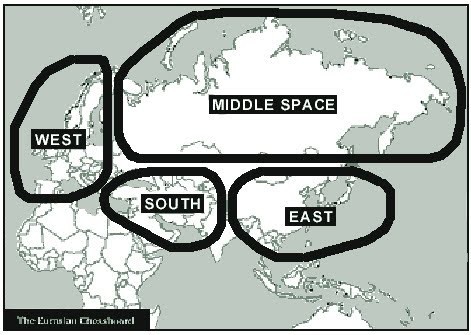 La Première Guerre mondiale, les révolutions russes de 1917, le renversement du tsarisme et la guerre civile jusqu’en 1921 bouleversent les héritiers du slavophilisme. C’est au sein de l’émigration russe blanche qu’émerge alors l’eurasisme. Exilés à Prague et à Paris, les premiers eurasistes, Nicolas Troubetskoï, Pierre Savitsky, Georges Vernadsky, Pierre Suvchinskiy, redécouvrent le caractère asiatique de leur histoire et réhabilitent les deux cent cinquante ans d’occupation tataro-mongole. Saluant l’œuvre des khan de Karakorum, ils conçoivent l’espace russe comme un troisième monde particulier. S’ils proclament le caractère eurasien des régions actuellement ukrainiennes de la Galicie, de la Volhynie et de la Podolie, ils se désintéressent superbement des Balkans, du Caucase et de la Crimée. Parfois précurseurs d’une troisième voie, certains d’entre-eux approuvent le renouveau soviétique sous la férule de Staline si bien que quelques-uns retournent en U.R.S.S. pour se retrouver envoyés au Goulag ou exécutés.
La Première Guerre mondiale, les révolutions russes de 1917, le renversement du tsarisme et la guerre civile jusqu’en 1921 bouleversent les héritiers du slavophilisme. C’est au sein de l’émigration russe blanche qu’émerge alors l’eurasisme. Exilés à Prague et à Paris, les premiers eurasistes, Nicolas Troubetskoï, Pierre Savitsky, Georges Vernadsky, Pierre Suvchinskiy, redécouvrent le caractère asiatique de leur histoire et réhabilitent les deux cent cinquante ans d’occupation tataro-mongole. Saluant l’œuvre des khan de Karakorum, ils conçoivent l’espace russe comme un troisième monde particulier. S’ils proclament le caractère eurasien des régions actuellement ukrainiennes de la Galicie, de la Volhynie et de la Podolie, ils se désintéressent superbement des Balkans, du Caucase et de la Crimée. Parfois précurseurs d’une troisième voie, certains d’entre-eux approuvent le renouveau soviétique sous la férule de Staline si bien que quelques-uns retournent en U.R.S.S. pour se retrouver envoyés au Goulag ou exécutés.
Pensée « géographiste », voire géopolitiste, parce qu’elle prend en compte l’espace steppique, l’eurasisme ne dure qu’une dizaine d’années et semble disparu en 1945. Remarquons que le numéro-culte d’Éléments consacré à la Russie en 1986 ignore l’eurasisme pourtant présent en filigrane dans certains milieux restreints du P.C.U.S. (41). Cependant, la transmission entre le premier eurasisme et l’eurasisme actuel revient à Lev Goumilev qui sut élaborer un nouvel eurasisme à portée ethno-biologico-naturaliste. Le néo-eurasisme resurgit dans les années 1990 et prend rapidement un ascendant certain au sein du gouvernement. Dès 1996, un eurasiste connu, l’arabophone Evgueni Primakov, devient ministre des Affaires étrangères avant d’être nommé président du gouvernement russe entre 1998 et 1999.
Aujourd’hui, le néo-eurasisme russe se structure autour de trois principaux pôles. Activiste métapolitique de grand talent, Alexandre Douguine ajoute aux travaux des précurseurs et de Goumilev divers apports d’origine ouest-européenne comme l’école de la Tradition primordiale (Guénon et Evola), de la « Révolution conservatrice » allemande, des « Nouvelles Droites » françaises, thioises et italiennes, et des approches marxistes hétérodoxes d’ultra-gauche (42). Un autre « courant, autour de la revue Evrazija (Eurasie) d’Édouard Bagramov, est plus culturel et folkloriste, explique Marlène Laruelle. Son thème central est la mixité, l’alliance slavo-turcique, qu’il illustre par la réhabilitation de l’Empire mongol et des minorités turco-musulmanes dans l’histoire russe, par une comparaison entre religiosité orthodoxe et mysticisme soufi : la fidélité à la Russie serait ainsi le meilleur mode de protection de l’identité nationale des petits peuples eurasiens. Sur le plan politique, Evrazija appelle à la reconstitution d’une unité politique et économique de l’espace post-soviétique autour du projet du président Nazarbaev, qui finance en partie la revue. Le troisième et dernier grand courant eurasiste, celui d’Alexandre Panarine et de Boris Erassov, est le plus théorique puisqu’il tente de réhabiliter la notion d’« empire » : l’empire ne serait ni un nationalisme étroit ni un impérialisme agressif mais une nouvelle forme de citoyenneté, d’« étaticité » reposant sur des valeurs et des principes et non sur le culte d’une nation. Il incarnerait sur le plan politique la diversité nationale de l’Eurasie et annoncerait au plan international l’arrivée d’un monde dit “ post-moderne ” où les valeurs conservatrices, religieuses et ascétiques gagneraient sur les idéaux de progrès de l’Occident (43) ». Treize ans plus tard, en dépit du décès de Goumilev et de Panarine, cette répartition théorique persiste avec l’apparition d’« un courant néo-eurasiste sinophile, incarné par Mikhaïl Titarenko, le directeur de l’Institut d’Extrême-Orient de l’Académie des Sciences (44) ». Quoique balbutiante, cette orientation tend à s’affirmer progressivement. « Les cinq cents ans de domination de l’Occident sur le monde sont en train de s’achever, assurait en 2007 Anatoli Outkine, historien à l’Institut des États-Unis et du Canada de l’Académie des Sciences, et, in extremis, la Russie a réussi à prendre le train des nouveaux pays qui montent, aux côtés de la Chine, de l’Inde et du Brésil. […] L’Europe aurait pu être le centre du monde si seulement la Russie avait été acceptée dans l’O.T.A.N. et l’Union européenne. […] En 2025, c’est Shanghai qui sera le centre du monde, et la Russie sera dans le camp de l’Orient. Aujourd’hui, nous n’attendons plus rien de l’Occident (45). » « L’Extrême-Orient est systématiquement valorisé dans les discours officiels russes comme une région d’avenir, signale Marlène Laruelle. Son évocation participe en effet de l’idée que la Russie est une puissance asiatique ayant un accès direct à la région la plus dynamique du monde, l’Asie – Pacifique dont elle est partie intégrante. Si tel est le cas sur le plan géographique – bien que l’Asie du Nord soit marginale, économiquement, comparée à l’Asie du Sud, qui concentre le dynamisme actuel -, il n’en est rien au niveau économique. Le commerce transfrontalier avec la Chine est bel et bien en pleine expansion, et des projets de zone de libre-échange entre la Russie, la Chine et la Corée du Sud sont à l’ordre du jour. Mais, globalement, l’économie russe est encore peu tournée vers l’Asie et peu intégrée à ses mécanismes régionaux (46). »
 L’eurasisme n’est pas propre à la Russie. Le Kazakhstan de Nursultan Nazarbaïev assume, lui aussi, cette idéologie. Inquiet des revendications territoriales de Soljénitsyne, il a transféré la capitale d’Almaty à une ville créée ex-nihilo, Astana, dont l’université d’État s’appelle officiellement Lev-Goumilev… Dans le n° 1 de Conflits, Tancrède Josserand traite avec brio de l’eurasisme turc (47). L’eurasisme est aussi présent en Hongrie via le pantouranisme dont le Jobbik se veut le continuateur. Mais, dans ce dernier cas, l’idéocratie eurasiste exprimée en Mitteleuropa apparaît surtout comme un cheval de Troie pro-turc. Le Jobbik souhaiterait que l’Union européenne s’ouvre à Ankara. Avec lucidité, Jean-Sylvestre Mongrenier estime que « lorsque ce type de production n’est pas destiné à promouvoir la candidature turque à l’Union européenne, l’« eurasisme » européen accorde une place centrale à l’alliance russe, la mission historique de la “ Troisième Rome ” consistant faire de l’Asie du Nord le prolongement géopolitique de l’Europe. Aussi serait-il plus adéquat de parler d’« Eurosibérie » (48) ».
L’eurasisme n’est pas propre à la Russie. Le Kazakhstan de Nursultan Nazarbaïev assume, lui aussi, cette idéologie. Inquiet des revendications territoriales de Soljénitsyne, il a transféré la capitale d’Almaty à une ville créée ex-nihilo, Astana, dont l’université d’État s’appelle officiellement Lev-Goumilev… Dans le n° 1 de Conflits, Tancrède Josserand traite avec brio de l’eurasisme turc (47). L’eurasisme est aussi présent en Hongrie via le pantouranisme dont le Jobbik se veut le continuateur. Mais, dans ce dernier cas, l’idéocratie eurasiste exprimée en Mitteleuropa apparaît surtout comme un cheval de Troie pro-turc. Le Jobbik souhaiterait que l’Union européenne s’ouvre à Ankara. Avec lucidité, Jean-Sylvestre Mongrenier estime que « lorsque ce type de production n’est pas destiné à promouvoir la candidature turque à l’Union européenne, l’« eurasisme » européen accorde une place centrale à l’alliance russe, la mission historique de la “ Troisième Rome ” consistant faire de l’Asie du Nord le prolongement géopolitique de l’Europe. Aussi serait-il plus adéquat de parler d’« Eurosibérie » (48) ».
Existe-t-il en Chine une pensée eurasiste ? Impossible en l’état de répondre à cette question. Ces derniers jours, les médiats ont rapporté que Pékin aimerait construire une ligne à grande vitesse de 13 000 km qui relierait le Nord-Ouest de la Chine aux États-Unis en deux jours par un train roulant à 350 km/h. Cette hypothétique L.G.V. traverserait la Sibérie, l’Alaska et le Canada et franchirait le détroit de Béring par un tunnel de 200 km (49). En revanche existe au Japon jusqu’en 1941 une mouvance eurasiste. Entre 1905 et 1940, les milieux cultivés de l’archipel débattent avec vigueur de deux orientations géopolitiques contradictoires : le Nanshin-ron ou « Doctrine d’expansion vers le Sud » (l’Asie du Sud-Est et les îles du Pacifique, ce qui implique d’affronter les puissances européennes et étasunienne) et le Hokushin-ron ou « Doctrine d’expansion vers le Nord » (à savoir combattre l’U.R.S.S. – Russie afin de s’emparer de la partie Nord de Sakhaline, de la Mongolie, de Vladivostok, du lac Baïkal et de la Sibérie centrale). Adversaire de la Faction du contrôle (Toseiha) de Tojo, le Kodoha (ou Faction de la voie impériale) du général Sadao Araki a en partie défendu l’Hokushin-ron. La synthèse revient à Tokutomi Sohô qui se prononce en faveur d’une invasion simultanée du Nord et du Sud, d’où l’affirmation dans un second temps d’une visée pan-asiatique. On sait cependant que la poussée vers le Nord est brisée lors de la défaite nippone de Khalkin-Gol en 1939 (50). Cette digression extrême-orientale n’est pas superflue. Robert Steuckers rappelle que le Kontinentalblock de Karl Haushofer a été « très probablement repris des hommes d’État japonais du début du XXe siècle, tels le prince Ito, le comte Goto et le Premier ministre Katsura, avocats d’une alliance grande-continentale germano-russo-japonaise (51) ».
Éclectique au Japon, en Turquie, en Hongrie, l’eurasisme l’est aussi en Russie. « L’idéologie néo-eurasiste, précise Marlène Laruelle, peut ainsi se présenter comme une science naturelle (Goumilev), une géopolitique et un spiritisme (Douguine), une intégration économique (Nazarbaev, organes de la C.E.I.), un mode de gestion des problèmes internes de la Fédération (eurasisme turcique), une philosophie de l’histoire (Panarine), une “ culturologie ” (Bagramov), un nouveau terrain scientifique (Vestnik Evrazii) (52) », d’où une multiplicité de contentieux internes : Panarine et Bagramov ont par exemple critiqué les approches biologisantes, ethnicisantes et métapolitiques de Goumilev et de Douguine.
L’eurasisme reste un pragmatisme géopolitique qui, à rebours de l’idée eurosibérienne, prend en compte la diversité ethno-spirituelle des peuples autochtones de Sibérie. Quid en effet dans l’Eurosibérie ethnosphérique de leur existence ? Le territoire sibérien n’est pas un désert humain. Y vivent des peuples minoritaires autochtones tels les Samoyèdes, les Bouriates, les Yakoutes, etc. Il ne faut pas avoir à ce sujet une volonté assimilatrice comme l’appliquèrent les Russes tsaristes et les Soviétiques. La nature de la Russie est d’être multinationale. Entre ici les notions complémentaires d’ethnopolitique et de psychologie des peuples. « Il convient d’attacher la plus grande importance à l’étude de ces unités secondaires qu’en France on appelle régions et pays, déclare Abel Miroglio […]. Une bonne psychologie nationale ne peut se dispenser de s’appuyer sur la connaissance des diverses régions; bien sûr, elle la domine, elle ne s’y réduit pas; et pareillement la psychologie de la région exige, pour être bien conduite, l’étude de ses divers terroirs (53). » Par conséquent, si la société russe adopte une solution nationaliste telle que la défendent des « nationaux-démocrates » anti-Poutine à la mode Alexeï Navalny, elle perdra inévitablement les territoires sibériens. Or ce vaste espace participe pleinement à la civilisation russe. « La civilisation est un ensemble plus large qui peut contenir plusieurs cultures, juge Gaston Bouthoul. Car la civilisation est un complexe très général dont les dominantes sont les connaissances scientifiques et techniques et les principales doctrines philosophiques. Les cultures, tout en participant de la civilisation à laquelle elles appartiennent, présentent surtout des différences de traditions esthétiques, historiques et mythiques (54). » La civilisation russe est polyculturaliste qui est l’exact contraire radical du multiculturalisme marchand.
Voilà pourquoi Douguine assigne à l’Orthodoxie, au judaïsme, à l’islam et au chamanisme – animisme le rang de religions traditionnelles, ce que n’ont pas le catholicisme et les protestantismes représentés dans l’étranger proche par une multitude de sectes évangéliques d’origine étatsunienne. C’est ainsi qu’il faut comprendre son fameux propos : « Le rejet du chauvinisme, du racisme et de la xénophobie procède d’abord chez moi d’une fidélité à la philosophie des premiers Eurasistes, qui soulignaient de façon positive le mélange de races et d’ethnies dans la formation et le développement de l’identité russe et surtout grand-russe. Il est par ailleurs une conséquence logique des principes de la géopolitique, selon lesquels le territoire détermine en quelque sorte le destin de ceux qui y vivent (le Boden vaut plus que le Blut) (55) ». Rien de surprenant de la part d’Alexandre Douguine, traditionaliste de confession orthodoxe vieux-croyants. Il ajoute même que, pour lui, « le traditionalisme est la source de l’inspiration, le point de départ. Mais il faut le développer plus avant, le vivre, le penser et repenser (56) ».
Alexandre Douguine, en lecteur attentif de Carl Schmitt, systématise l’opposition entre la Terre et la Mer (57), entre les puissances telluriques et les puissances thalassocratiques. Alors que triomphe une « vie liquide » décrite par Zygmunt Bauman (58), sa démarche nettement tellurocratique est cohérente puisqu’elle s’appuie sur le Sol et non sur le Sang dont la nature constitue, en dernière analyse, un liquide. Et puis, en authentique homme de Tradition, Douguine insiste sur le fait, primordial à ses yeux, qu’ « un Eurasiste n’est donc nullement un “ habitant du continent eurasiatique ”. Il est bien plutôt l’homme qui assume volontairement la position d’une lutte existentielle, idéologique et métaphysique, contre l’américanisme, la globalisation et l’impérialisme des valeurs occidentales (la “ société ouverte ”, les “ droits de l’homme ”, la société de marché). Vous pouvez donc très bien être eurasiste en vivant en Amérique latine, au Canada, en Australie ou en Afrique (59) ». Marlène Laruelle considère néanmoins que « si l’eurasisme est bien un nationalisme, il se différencie des courants ethnonationalistes plus classiques par sa mise en valeur de l’État et non de l’ethnie, par son assimilation entre Russie et Eurasie, entre nation et Empire, et emprunte beaucoup au discours soviétique (60) ». Il est évident que les eurasistes pensent en terme d’empire et non en nation pourvue de « frontières naturelles » établies et reconnues. Guère suspect de cosmopolitisme, l’écrivain Vladimir Volkoff fait dire dans son roman uchronique, Alexandra, à Ivan Barsoff, l’un des personnages principaux qui emprunte pas mal des traits de l’auteur, qui est le Premier ministre de cette tsarine, que son empire russe « n’a pas de limites naturelles (à moins que ce soient les océans Arctique et Indien, Pacifique et Atlantique), il n’a pas d’unité linguistique, ni raciale, ni même religieuse : il est tissu autour d’une triple colonne torsadée constituée par l’orthodoxie, la monarchie et l’idéalisme du peuple russe servant de noyau aux autres (61) ».
Par-delà les écrits de Guillaume Faye, de Jean Thiriart, de Maurice G. Dantec, des eurasistes ou des officiers nippons, tous veulent maîtriser le Heartland, ce « Cœur de la Terre ». Correspondant à l’ensemble Oural – Sibérie occidentale, cette notion revient au Britannique Halford Mackinder qui l’écrit en 1904 dans « Le pivot géographique de l’Histoire ». Pour Mackinder, le Heartland est un espace inaccessible à la navigation depuis l’Océan. Pour Jean-Sylvestre Mongrenier, « le concept de Heartland et celui d’Eurasie […] se recoupent partiellement (62) ». Il entérine ce qu’avance Zbignew Brzezinski à propos de cette zone-pivot : « Passant de l’échelle régionale à l’approche planétaire, la géopolitique postule que la prééminence sur le continent eurasien sert de point d’ancrage à la domination globale (63) ». Le grand géopolitologue étatsunien se réfère implicitement à la thèse de Mackinder pour qui contrôler le Heartland revient à dominer l’Île mondiale formée de l’Europe, de l’Asie et de l’Afrique, et donc à maîtriser le monde entier. Cette célèbre formulation ne lui appartient pas. L’historien François Bluche rapporte qu’en novembre 1626, le chevalier de Razilly adresse à Richelieu un mémoire dans lequel est affirmé que « “ Quiconque est maître de la mer, a un grand pouvoir sur terre ”. [Cette trouvaille] poursuivra le Cardinal, l’obsédera, inspirera directement le Testament politique (64) ». « L’Eurasie demeure, en conséquence, l’échiquier sur lequel se déroule le combat pour la primauté globale (65). » Il faut toutefois se garder des leurres propres au « géopolitisme ». Ce dernier « est venu combler le vide provoqué par les basses pressions idéologiques. Il ne s’agit pas de recourir à la géographie fondamentale – comme savoir scientifique et méthode d’analyse – pour démêler l’écheveau des conflits et tenter d’apporter des réponses aux défis des temps présents, mais d’une vision idéologique qui se limite à quelques pauvres axiomes : la Russie est située au cœur du Heartland et elle est appelée à dominer (66) ».
Attention cependant à ne pas verser dans le manichéisme géopolitique ! Toute véritable puissance doit d’abord se penser amphibie, car, à la Terre et à la Mer, une stratégie complète s’assure maintenant de la projection des forces tout en couvrant les dimensions aérienne, sous-marine, spatiale ainsi que le cyberespace et la guerre de l’information. C’est ainsi qu’il faut saisir qu’à la suite de Robert Steuckers, « l’eurasisme, dans notre optique, relève bien plutôt d’un concept géographique et stratégique (67) ».
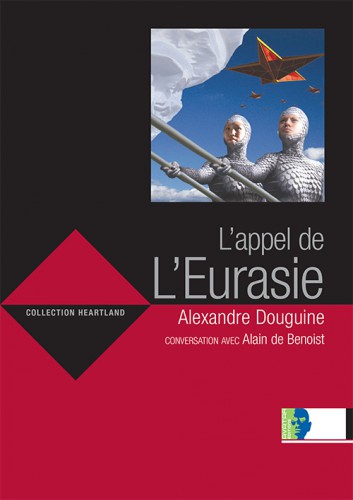 De nouvelles études sur les écrits de Mackinder démontrent en fait qu’il attachait une importance cruciale au Centreland, la « Terre centrale arabe », qui coïncide avec le Moyen-Orient. Et puis, que se soit l’Eurosibérie ou l’Eurasie, l’autorité organisatrice de l’espace politique ainsi créé doit se préoccuper de la gestion des immenses frontières terrestres et maritimes. Actuellement, les États-Unis ont beau avoir fortifié leur mur en face du Mexique, ils n’arrivent pas à contenir les flux migratoires clandestins des Latinos. L’Union pseudo-européenne est incapable de ralentir la submersion migratoire à travers la Méditerranée. Même si toutes les frontières eurosibériennes étaient sous surveillance électronique permanente et si était appliquée une préférence européenne, à la rigueur nationale, voire ethno-régionale, il est probable que cela freinerait l’immigration, mais ne l’arrêterait pas, à moins d’accepter la décroissance pour soi, une économie de puissance pour la communauté géopolitique et la fin de la libre circulation pour tous en assignant à chacun un territoire de vie précis.
De nouvelles études sur les écrits de Mackinder démontrent en fait qu’il attachait une importance cruciale au Centreland, la « Terre centrale arabe », qui coïncide avec le Moyen-Orient. Et puis, que se soit l’Eurosibérie ou l’Eurasie, l’autorité organisatrice de l’espace politique ainsi créé doit se préoccuper de la gestion des immenses frontières terrestres et maritimes. Actuellement, les États-Unis ont beau avoir fortifié leur mur en face du Mexique, ils n’arrivent pas à contenir les flux migratoires clandestins des Latinos. L’Union pseudo-européenne est incapable de ralentir la submersion migratoire à travers la Méditerranée. Même si toutes les frontières eurosibériennes étaient sous surveillance électronique permanente et si était appliquée une préférence européenne, à la rigueur nationale, voire ethno-régionale, il est probable que cela freinerait l’immigration, mais ne l’arrêterait pas, à moins d’accepter la décroissance pour soi, une économie de puissance pour la communauté géopolitique et la fin de la libre circulation pour tous en assignant à chacun un territoire de vie précis.
Vu leur superficie, l’Eurosibérie ou l’Eurasie n’incarnent-elles pas de véritables démesures géopolitiques ? Si oui, elles portent en leur sein des germes inévitables de schisme civilisationnel comme l’a bien vu en poète-visionnaire le romancier Jean-Claude Albert-Weill. Dans Sibéria, le troisième et dernier volume de L’Altermonde, magnifique fresque uchronique qui dépeint une Eurosibérie fière d’elle-même et rare roman vraiment néo-droitiste de langue française (68), on perçoit les premières divergences entre une vieille Europe, adepte du Chat, et une nouvelle, installée en Sibérie, qui vénère le Rat.
Le risque d’éclatement demeure sous-jacent en Russie, particulièrement en Sibérie. Dès les années 1860 se manifestait un mouvement indépendantiste sibérien de Grigori Potanine, chantre de « La Sibérie aux Sibériens ! ». Libéral nationalitaire, ce mouvement fomenta vers 1865 une insurrection qui aurait bénéficié de l’appui de citoyens américains et d’exilés polonais. Quelques années plus tôt, vers 1856 – 1857, des entreprises étatsuniennes se proposaient de financer l’entière réalisation de voies ferrées entre Irkoutsk et Tchita. La Russie déclina bien sûr la proposition. Pendant la guerre civile russe, Potanine présida un gouvernement provisoire sibérien hostile à la fois aux « Rouges » et aux « Blancs ». Ce séparatisme continue encore. En octobre 1993, en pleine crise politique, Sverdlovsk adopta une constitution pour la « République ouralienne ». Plus récemment, en 2010, le F.S.B. s’inquiéta de l’activisme du groupuscule Solution nationale pour la Sibérie qui célèbre Potanine… Il est à parier que des officines occidentales couvent d’un grand intérêt d’éventuelles séditions sibériennes qui, si elles réussissaient, briseraient définitivement tout projet d’eurasisme ou d’Eurosibérie.
L’Eurosibérie « est un “ paradigme ”, c’est-à-dire un idéal, un modèle, un objectif qui comporte la dimension d’un mythe concret, agissant et mobilisateur, annonce Guillaume Faye (69) ». Il s’agit d’un mythe au sens sorélien du terme qui comporte le risque de remettre à plus tard l’action décisive. Pour y remédier, faisons nôtre le slogan du penseur écologiste Bernard Charbonneau : « Penser global, agir local ». Si le global est ici l’idéal eurosibérien, voire eurasiste, l’action locale suppose en amont un lent et patient travail fractionnaire d’édification d’une contre-société identitaire en sécession croissante de la présente société multiculturaliste marchande avariée. Par la constitution informelle mais tangibles de B.A.D. (bases autonomes durables), « il faut, en lisière du Système, construire un espace où incuber d’autres structures sociales et mentales. À l’intérieur de cet espace autonomisé, il sera possible de reconstituer les structures de l’enracinement (70) ».
Les zélotes du métissage planétaire se trompent. L’enracinement n’est ni l’enfermement ou le repli sur soi. Soutenir un enracinement multiple ou plus exactement un enracinement multiscalaire – à plusieurs échelles d’espace différencié – paraît le meilleur moyen de concilier l’amour de sa petite patrie, la fidélité envers sa patrie historique et l’ardent désir d’œuvrer en faveur de sa grande patrie continentale quelque que soit sa désignation, car « l’enracinement est peut-être le besoin le plus important et le plus méconnu de l’âme humaine. C’est un des plus difficiles à définir. Un être humain a une racine par sa participation réelle, active et naturelle à l’existence d’une collectivité qui conserve vivants certains trésors du passé et certains pressentiments d’avenir. Participation naturelle, c’est-à-dire amenée automatiquement par le lieu, la naissance, la profession, l’entourage. Chaque être humain a besoin d’avoir de multiples racines. Il a besoin de recevoir la presque totalité de sa vie morale, intellectuelle, spirituelle, par l’intermédiaire des milieux dont il fait naturellement partie (71) ». N’oublions jamais qu’au-delà des enjeux géopolitiques, notre combat essentiel demeure la persistance de notre intégrité d’Albo-Européen.
Je vous remercie.
Georges Feltin-Tracol
Notes
1 : Cf. la tribune délirante, summum de politiquement correct, de Thimothy Snyder, « La Russie contre Maïdan », in Le Monde, 23 et 24 février 2014; « Poutine doit écraser le virus de Maïdan… Entretien avec Lilia Chevtsova par Vincent Jauvert », in Le Nouvel Observateur, 27 février 2014; Bruno Tertrais, « La rupture ukrainienne », in Le Figaro, 25 avril 2014; Chantal Delsol, « Occident – Russie : modernité contre tradition ? », in Le Figaro, 30 avril 2014; Jean-Marie Chauvier, « Eurasie, le “ choc des civilisations ” version russe », in Le Monde diplomatique, mai 2014; Vincent Jauvert, « Le Raspoutine de Poutine », in Le Nouvel Observateur, 1er mai 2014; Isabelle Lasserre, « Grande serbie, Grande Russie, une idéologie commune », in Le Figaro, 6 mai 2014, etc.
2 : Ainsi, dans Le Monde du 18 janvier 2001, Marie Jégo évoquait-elle le projet poutinien de restauration d’un ensemble néo-soviétique en se référant aux Fondements de géopolitique (non traduit) de Douguine.
3 : Sur les œuvres de Douguine disponibles en français, se reporter à Georges Feltin-Tracol, « Rencontre avec Alexandre Douguine », in Réflexions à l’Est, Alexipharmaque, coll. « Les Réflexives », Billère, 2012, note 5 p. 220. On rajoutera depuis la parution de cet ouvrage : Alexandre Douguine, L’appel de l’Eurasie. Conversation avec Alain de Benoist, Avatar, coll. « Heartland », Étampes, 2013; Alexandre Douguine, La Quatrième théorie politique. La Russie et les idées politiques du XXIe siècle, Ars Magna Éditions, Nantes, 2012; Alexandre Douguine, Pour une théorie du monde multipolaire, Ars Magna Éditions, Nantes, 2013.
4 : Guillaume Faye, L’archéofuturisme, L’Æncre, Paris, 1998, p. 192.
5 : Sur ce projet mitterrandien méconnu, cf. Roland Dumas, « Un projet mort-né : la Confédération européenne », in Politique étrangère, volume 66, n° 3, 2001, pp. 687 – 703.
6 : Guillaume Faye, L’archéofuturisme, op. cit., p. 192.
7 : Idem, p. 194.
8 : cf. Guillaume Faye, « Pour en finir avec la civilisation occidentale », in Éléments, n° 34, avril – mai 1980, pp. 5 – 11.
9 : Guillaume Faye, L’archéofuturisme, op. cit., p. 75, souligné par l’auteur.
10 : cf. Guillaume Faye, « Il n’y a pas de “ monde blanc ” », in Éléments, n° 34, avril – mai 1980, p. 6.
11 : Jean Cau, Discours de la décadence, Copernic, coll. « Cartouche », Paris, 1978 pp. 164 – 165.
12 : Idem, p. 175, souligné par l’auteur.
13 : Id., p. 182, souligné par l’auteur.
14 : Id., p. 183, souligné par l’auteur.
15 : Guillaume Faye, Pourquoi nous combattons. Manifeste de la résistance européenne, L’Æncre, Paris, 2001, p. 119.
16 : Id., p. 123, souligné par l’auteur.
17 : Id., p. 124.
18 : Tom Clancy, L’Ours et le Dragon, Albin Michel, Paris, 2001 (1re édition originale en 2000), deux tomes.
19 : Maurice G. Dantec, Le théâtre des opérations 2000 – 2001. Laboratoire de catastrophe générale, Gallimard, Paris, 2001, pp. 594 – 595.
20 : L’Édit de Caracalla ou Plaidoyer pour des États-Unis d’Occident, par Xavier de C***, traduit de l’anglais (américain), et suivi d’une épitaphe par Régis Debray, Fayard, Paris, 2002.
21 : Jean-Sylvestre Mongrenier, Dictionnaire géopolitique de la défense européenne. Du traité de Bruxelles à la Constitution européenne, Éditions Unicomm, coll. « Abécédaire Société – Défense européenne », Paris, 2005, p. 235.
22 : « Contre le communisme ou l’islamisation, je me suis toujours battu pour préserver notre identité. Entretien avec Jean-Marie Le Pen », in Minute, 28 décembre 2011, p. 5.
23 : Maurice G. Dantec, American Black Box. Le théâtre des opérations 2002 – 2006, Albin Michel, Paris, 2007, p. 174.
24 : Idem, p. 119.
25 : Id., p. 66.
26 : Id., p. 122.
27 : Rodolphe Badinand, Requiem pour la Contre-Révolution. Et autres essais impérieux, Alexipharmaque, coll. « Les Réflexives », Billère, 2009, pp. 123 – 124.
28 : Cf. Francis Parker Yockey, Le prophète de l’Imperium, Avatar, coll. « Heartland », Paris - Dun Carraig, 2004; Francis Parker Yockey, Imperium. La philosophie de l’histoire et de la politique, Avatar, coll. « Heartland », Paris - Dun Carraig, 2008 (1re édition originale en 1948); Francis Parker Yockey, L’Ennemi de l’Europe, Ars Magna Éditions, Nantes, 2011 (1re édition originale en 1956).
29 : cf. Jean Thiriart, Un Empire de quatre cents millions d’hommes, l’Europe. La naissance d’une nation, au départ d’un parti historique, Avatar, coll. « Heartland », Paris - Dublin, 2007 (1re édition originale en 1964).
30 : Jean Thiriart, « Europe : l’État-nation politique », in Nationalisme et République, n° 8, 1er juin 1992, p. 3.
31 : Jean Thiriart, art. cit., p. 5.
32 : Idem, p. 6, souligné par l’auteur.
33 : Aymeric Chauprade, Géopolitique. Constantes et changements dans l’histoire, Ellipses, Paris, 2003, p. 475.
34 : Sur l’histoire et les principales lignes de force de l’eurasisme, on consultera avec un très grand profit de Marlène Laruelle, L’idéologie eurasiste russe. Ou comment penser l’empire, L’Harmattan, coll. « Essais historiques », Paris, 1999; Mythe aryen et rêve impérial dans la Russie du XXIe siècle, C.N.R.S. – Éditions, coll. « Mondes russes. États, sociétés, nations », Paris, 2005; La quête d’une identité impériale. Le néo-eurasisme dans la Russie contemporaine, Petra Éditions, 2007; Le nouveau nationalisme russe. Des repères pour comprendre, L’Œuvre Éditions, Paris, 2010; de Lorraine de Meaux, La Russie et la tentation de l’Orient, Fayard, Paris, 2010; de Georges Nivat, Vers la fin du mythe russe. Essais sur la culture russe de Gogol à nos jours, L’Âge d’Homme, coll. « Slavica », Lausanne, 1982, en particulier « Du “ panmongolisme ” au “ mouvement eurasien ” », pp. 138 – 155; Vivre en russe, L’Âge d’Homme, coll. « Slavica », Lausanne, 2007, en particulier « Les paradoxes de l’« affirmation eurasienne » », pp. 81 – 102.
35 : Cf. sur le blogue de Lionel Baland, « Secteur droit entre en politique », mis en ligne le 6 mars 2014.
36 : Alain Cagnat, « Europe, Eurasie, Eurosibérie, l’éclairage géopolitique », in Terre et Peuple, n° 59, Équinoxe de Printemps 2014, p. 18.
37 : « La Russie vue par les Biélorusses », mis en ligne sur Le Courrier de la Russie, le 13 décembre 2013, cf. http://www.lecourrierderussie.com/2013/12/la-russie-vue-par-les-bielorusses/
38 : « La Russie vue par les Biélorusses. En coulisses… », mis en ligne sur Le Courrier de la Russie, le 13 décembre 2013, cf. http://www.lecourrierderussie.com/2013/12/la-russie-vue-par-les-bielorusses/2/
39 : Alexandre Baounov, « Entre Kiev et Moscou », in La Russie d’aujourd’hui, supplément du Figaro, le 18 décembre 2013.
40 : Alexandre Soljénitsyne, Comment réaménager notre Russie ? Réflexions dans la mesure de mes forces, Fayard, Paris, 1990, traduit par Geneviève et José Johannet, p. 23, souligné par l’auteur.
41 : cf. Éléments, « La Russie : le dernier empire ? », n° 57 – 58, printemps 1986, pp. 19 – 41.
42 : cf. Alexandre Douguine, « Evola entre la droite et la gauche », collectif, Evola envers et contre tous !, Avatar, coll. «Orientation», Étampes - Dun Carraig, 2010.
43 : Marlène Laruelle, « Le renouveau des courants eurasistes en Russie : socle idéologique commun et diversité d’approches », in Slavica occitania, n° 11, 2000, p. 156.
44 : Marlène Laruelle, « De l’eurasisme au néo-eurasisme : à la recherche du Troisième Continent », in sous la direction de Hervé Coutau-Bégarie et Martin Motte, Approches de la géopolitique. De l’Antiquité au XXIe siècle, Économica, coll. « Bibliothèque Stratégique », Paris, 2013, p. 664.
45 : in Libération, 15 août 2007.
46 : Marlène Laruelle, « L’Extrême-Orient russe : la carte asiatique », in Questions Internationales, n° 57, septembre – octobre 2012, pp. 67 – 68.
47 : Tancrède Josserand, « L’eurasisme turc. La steppe comme ligne d’horizon », in Conflits, n° 1, avril – mai 2014, pp. 62 – 64.
48 : Jean-Sylvestre Mongrenier, Dictionnaire géopolitique de la défense européenne, op. cit., pp. 135 – 136.
49 : cf. Cécile de La Guérivière, « La Chine veut faire rouler un T.G.V. jusqu’aux États-Unis », in Le Figaro, 10 et 11 mai 2014.
50 : Jacques Sapir, La Mandchourie oubliée. Grandeur et démesure de l’art de la guerre soviétique, Éditions du Rocher, coll. « L’art de la guerre », Monaco, 1996.
51 : Robert Steuckers, La Révolution conservatrice allemande. Biographies de ses principaux acteurs et textes choisis, Les Éditions du Lore, Chevaigné, 2014, p. 131.
52 : Marlène Laruelle, « Le renouveau des courants eurasistes en Russie », art. cit., p. 159.
53 : Abel Miroglio, La psychologie des peuples, P.U.F., coll. « Que sais-je ? », n° 798, Paris, 1971, p. 7, souligné par l’auteur.
54 : Gaston Bouthoul, Les mentalités, P.U.F., coll. « Que sais-je ? », n° 545, Paris, 1952, p. 76, souligné par l’auteur.
55 : « Qu’est-ce que l’eurasisme ? Une conversation avec Alexandre Douguine », in Krisis, n° 32, juin 2009, p. 153.
56 : « La quatrième théorie politique d’Alexandre Douguine. Entretien », in Rébellion, n° 15, mars – avril 2012, p. 16.
57 : cf. Carl Schmitt, Terre et Mer. Un point de vue sur l’histoire mondiale, Le Labyrinthe, coll. « Les cahiers de la nouvelle droite », 1985, introduction et postface de Julien Freund, traduit par Jean-Louis Pesteil.
58 : cf. Zygmunt Bauman, La vie liquide, Éditions du Rouergue / Chambon, coll. « Les incorrects », Arles, 2006.
59 : « Qu’est-ce que l’eurasisme ? », art. cit., p. 127.
60 : Marlène Laruelle, « De l’eurasisme au néo-eurasisme : à la recherche du Troisième Continent », op. cit., p. 681.
61 : Jacqueline Dauxois et Vladimir Volkoff, Alexandra, Albin Michel, Paris, 1994, p. 444.
62 : Jean-Sylvestre Mongrenier, La Russie menace-t-elle l’Occident ?, Choiseul, Paris, 2009, p. 100.
63 : Zbignew Brzezinski, Le grand échiquier. L’Amérique et le reste du monde, Fayard, coll. « Pluriel », Paris, 2010 (1re édition originale en 1997), traduction de Michel Bessière et Michelle Herpe-Voslinsky, pp. 66 – 67.
64 : François Bluche, Richelieu, Perrin, Paris, 2003, p. 136.
65 : Zbignew Brzezinski, op. cit., pp. 59 et 61.
66 : Jean-Sylvestre Mongrenier, La Russie menace-t-elle l’Occident ?, op. cit., pp. 97 – 98.
67 : Robert Steuckers, « Eurasisme et atlantisme : quelques réflexions intemporelles et impertinentes », mis en ligne sur Euro-Synergies, le 20 mars 2009.
68 : Jean-Claude Albert-Weill, L’Altermonde, Éditions Gills Club La Panfoulia, Paris, 2004.
69 : Guillaume Faye, Pourquoi nous combattons, op. cit., p. 124, souligné par l’auteur.
70 : Serge Ayoub, Michel Drac, Marion Thibaud, G5G. Une déclaration de guerre, Les Éditions du Pont d’Arcole, Paris, 2012, p. 18.
71 : Simone Weil, L’enracinement, Gallimard, coll. « Folio – Essais », Paris, 1949, p. 61.




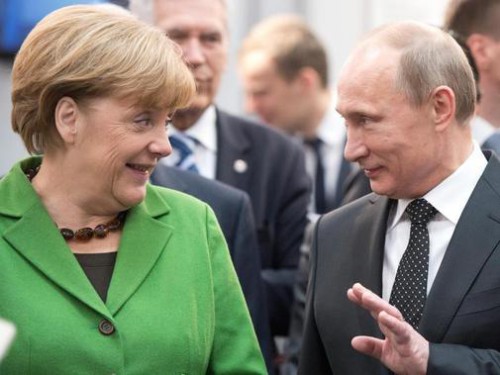

 del.icio.us
del.icio.us
 Digg
Digg
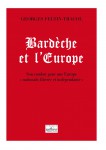
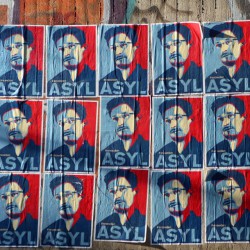
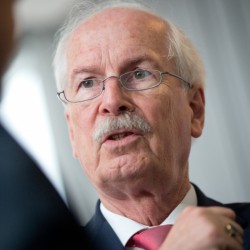
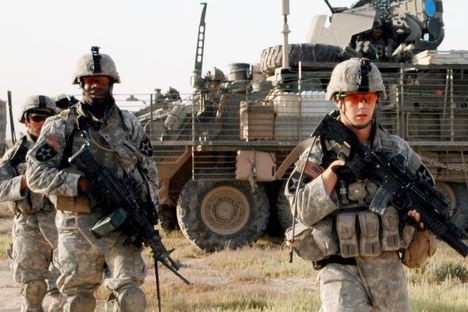
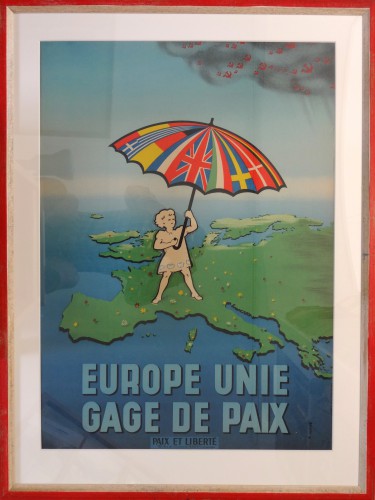
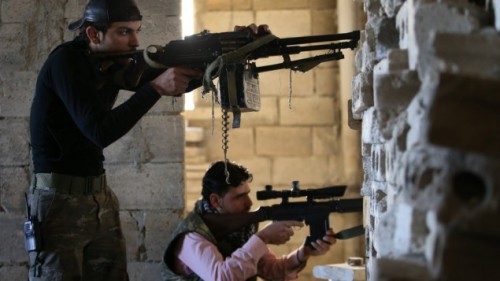
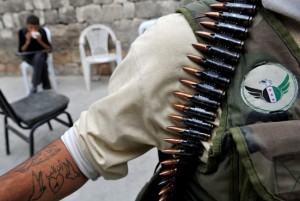 The third and final step the US must take upon losing a war is to leave chaos where victory was denied, and attach responsibility for the conflict to a disposable elected politician – in this case US President Barack Obama. While the war was clearly conceived during the administration of George Bush as early as 2007, it was executed under the watch of Obama. By attaching responsibility for the conflict to Obama, when his term is up and he passes into the hindsight of history, corporate-financier funded policy makers will have before them a clean slate upon which to begin carrying out the next leg of their continuous agenda.
The third and final step the US must take upon losing a war is to leave chaos where victory was denied, and attach responsibility for the conflict to a disposable elected politician – in this case US President Barack Obama. While the war was clearly conceived during the administration of George Bush as early as 2007, it was executed under the watch of Obama. By attaching responsibility for the conflict to Obama, when his term is up and he passes into the hindsight of history, corporate-financier funded policy makers will have before them a clean slate upon which to begin carrying out the next leg of their continuous agenda.



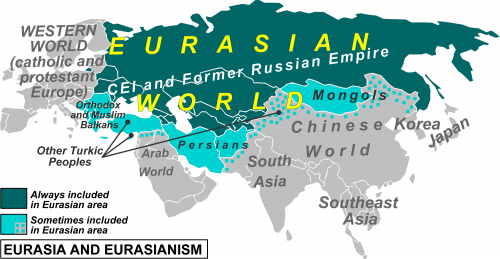

 La Première Guerre mondiale, les révolutions russes de 1917, le renversement du tsarisme et la guerre civile jusqu’en 1921 bouleversent les héritiers du slavophilisme. C’est au sein de l’émigration russe blanche qu’émerge alors l’eurasisme. Exilés à Prague et à Paris, les premiers eurasistes, Nicolas Troubetskoï, Pierre Savitsky, Georges Vernadsky, Pierre Suvchinskiy, redécouvrent le caractère asiatique de leur histoire et réhabilitent les deux cent cinquante ans d’occupation tataro-mongole. Saluant l’œuvre des khan de Karakorum, ils conçoivent l’espace russe comme un troisième monde particulier. S’ils proclament le caractère eurasien des régions actuellement ukrainiennes de la Galicie, de la Volhynie et de la Podolie, ils se désintéressent superbement des Balkans, du Caucase et de la Crimée. Parfois précurseurs d’une troisième voie, certains d’entre-eux approuvent le renouveau soviétique sous la férule de Staline si bien que quelques-uns retournent en U.R.S.S. pour se retrouver envoyés au Goulag ou exécutés.
La Première Guerre mondiale, les révolutions russes de 1917, le renversement du tsarisme et la guerre civile jusqu’en 1921 bouleversent les héritiers du slavophilisme. C’est au sein de l’émigration russe blanche qu’émerge alors l’eurasisme. Exilés à Prague et à Paris, les premiers eurasistes, Nicolas Troubetskoï, Pierre Savitsky, Georges Vernadsky, Pierre Suvchinskiy, redécouvrent le caractère asiatique de leur histoire et réhabilitent les deux cent cinquante ans d’occupation tataro-mongole. Saluant l’œuvre des khan de Karakorum, ils conçoivent l’espace russe comme un troisième monde particulier. S’ils proclament le caractère eurasien des régions actuellement ukrainiennes de la Galicie, de la Volhynie et de la Podolie, ils se désintéressent superbement des Balkans, du Caucase et de la Crimée. Parfois précurseurs d’une troisième voie, certains d’entre-eux approuvent le renouveau soviétique sous la férule de Staline si bien que quelques-uns retournent en U.R.S.S. pour se retrouver envoyés au Goulag ou exécutés. L’eurasisme n’est pas propre à la Russie. Le Kazakhstan de Nursultan Nazarbaïev assume, lui aussi, cette idéologie. Inquiet des revendications territoriales de Soljénitsyne, il a transféré la capitale d’Almaty à une ville créée ex-nihilo, Astana, dont l’université d’État s’appelle officiellement Lev-Goumilev… Dans le n° 1 de Conflits, Tancrède Josserand traite avec brio de l’eurasisme turc (47). L’eurasisme est aussi présent en Hongrie via le pantouranisme dont le Jobbik se veut le continuateur. Mais, dans ce dernier cas, l’idéocratie eurasiste exprimée en Mitteleuropa apparaît surtout comme un cheval de Troie pro-turc. Le Jobbik souhaiterait que l’Union européenne s’ouvre à Ankara. Avec lucidité, Jean-Sylvestre Mongrenier estime que « lorsque ce type de production n’est pas destiné à promouvoir la candidature turque à l’Union européenne, l’« eurasisme » européen accorde une place centrale à l’alliance russe, la mission historique de la “ Troisième Rome ” consistant faire de l’Asie du Nord le prolongement géopolitique de l’Europe. Aussi serait-il plus adéquat de parler d’« Eurosibérie » (48) ».
L’eurasisme n’est pas propre à la Russie. Le Kazakhstan de Nursultan Nazarbaïev assume, lui aussi, cette idéologie. Inquiet des revendications territoriales de Soljénitsyne, il a transféré la capitale d’Almaty à une ville créée ex-nihilo, Astana, dont l’université d’État s’appelle officiellement Lev-Goumilev… Dans le n° 1 de Conflits, Tancrède Josserand traite avec brio de l’eurasisme turc (47). L’eurasisme est aussi présent en Hongrie via le pantouranisme dont le Jobbik se veut le continuateur. Mais, dans ce dernier cas, l’idéocratie eurasiste exprimée en Mitteleuropa apparaît surtout comme un cheval de Troie pro-turc. Le Jobbik souhaiterait que l’Union européenne s’ouvre à Ankara. Avec lucidité, Jean-Sylvestre Mongrenier estime que « lorsque ce type de production n’est pas destiné à promouvoir la candidature turque à l’Union européenne, l’« eurasisme » européen accorde une place centrale à l’alliance russe, la mission historique de la “ Troisième Rome ” consistant faire de l’Asie du Nord le prolongement géopolitique de l’Europe. Aussi serait-il plus adéquat de parler d’« Eurosibérie » (48) ». De nouvelles études sur les écrits de Mackinder démontrent en fait qu’il attachait une importance cruciale au Centreland, la « Terre centrale arabe », qui coïncide avec le Moyen-Orient. Et puis, que se soit l’Eurosibérie ou l’Eurasie, l’autorité organisatrice de l’espace politique ainsi créé doit se préoccuper de la gestion des immenses frontières terrestres et maritimes. Actuellement, les États-Unis ont beau avoir fortifié leur mur en face du Mexique, ils n’arrivent pas à contenir les flux migratoires clandestins des Latinos. L’Union pseudo-européenne est incapable de ralentir la submersion migratoire à travers la Méditerranée. Même si toutes les frontières eurosibériennes étaient sous surveillance électronique permanente et si était appliquée une préférence européenne, à la rigueur nationale, voire ethno-régionale, il est probable que cela freinerait l’immigration, mais ne l’arrêterait pas, à moins d’accepter la décroissance pour soi, une économie de puissance pour la communauté géopolitique et la fin de la libre circulation pour tous en assignant à chacun un territoire de vie précis.
De nouvelles études sur les écrits de Mackinder démontrent en fait qu’il attachait une importance cruciale au Centreland, la « Terre centrale arabe », qui coïncide avec le Moyen-Orient. Et puis, que se soit l’Eurosibérie ou l’Eurasie, l’autorité organisatrice de l’espace politique ainsi créé doit se préoccuper de la gestion des immenses frontières terrestres et maritimes. Actuellement, les États-Unis ont beau avoir fortifié leur mur en face du Mexique, ils n’arrivent pas à contenir les flux migratoires clandestins des Latinos. L’Union pseudo-européenne est incapable de ralentir la submersion migratoire à travers la Méditerranée. Même si toutes les frontières eurosibériennes étaient sous surveillance électronique permanente et si était appliquée une préférence européenne, à la rigueur nationale, voire ethno-régionale, il est probable que cela freinerait l’immigration, mais ne l’arrêterait pas, à moins d’accepter la décroissance pour soi, une économie de puissance pour la communauté géopolitique et la fin de la libre circulation pour tous en assignant à chacun un territoire de vie précis.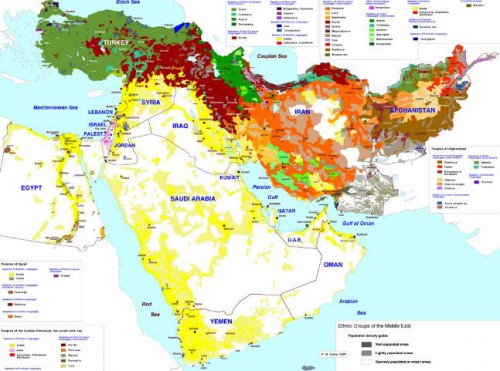
 Pour en revenir à l’Irak, la dissociation entre trois entités sunnite, chiite et kurde satisferait certains acteurs, mais en inquièterait beaucoup d’autres. Elle a été défendue par le président de l’Irak, le Kurde Jalal Talabani,( aujourd’hui en retrait pour des raisons de santé ), mais n’était pas plus recevable autrefois qu’elle ne le serait aujourd’hui par les autres partenaires. Par sa constitution, l’Irak est déjà un Etat unique, souverain, indépendant et fédéral ( Art. 1 ) ; les Kurdes y trouvent de nombreux avantages, ce qui explique leur soutien au gouvernement actuel. Ni la Turquie, ni l’Iran ne sont très favorables à la notion de « Kurdistan » ( la majorité du peuple kurde vit dans ces deux pays ) ; quant aux pays arabes du Golfe, ils ne veulent à aucun prix d’une extension du chiisme iranien sur la Mésopotamie. En résumé, le désordre, créé par l’intervention américaine n’est pas prêt de disparaître. Pour être juste, la politique revancharde envers les Sunnites du premier ministre chiite Nouri al-Maliki n’a pas amélioré les choses, au point que ce dernier est peut-être devenu un obstacle à tout règlement négocié. Oui, le monde devient bien dangereux, et on comprend qu’il est plus aisé de maintenir que de rompre l’intangibilité des frontières… Quelle que soit l’option choisie, le risque de mourir, pour rien ou non, sera présent ; autant que ce soit contre des barbares...
Pour en revenir à l’Irak, la dissociation entre trois entités sunnite, chiite et kurde satisferait certains acteurs, mais en inquièterait beaucoup d’autres. Elle a été défendue par le président de l’Irak, le Kurde Jalal Talabani,( aujourd’hui en retrait pour des raisons de santé ), mais n’était pas plus recevable autrefois qu’elle ne le serait aujourd’hui par les autres partenaires. Par sa constitution, l’Irak est déjà un Etat unique, souverain, indépendant et fédéral ( Art. 1 ) ; les Kurdes y trouvent de nombreux avantages, ce qui explique leur soutien au gouvernement actuel. Ni la Turquie, ni l’Iran ne sont très favorables à la notion de « Kurdistan » ( la majorité du peuple kurde vit dans ces deux pays ) ; quant aux pays arabes du Golfe, ils ne veulent à aucun prix d’une extension du chiisme iranien sur la Mésopotamie. En résumé, le désordre, créé par l’intervention américaine n’est pas prêt de disparaître. Pour être juste, la politique revancharde envers les Sunnites du premier ministre chiite Nouri al-Maliki n’a pas amélioré les choses, au point que ce dernier est peut-être devenu un obstacle à tout règlement négocié. Oui, le monde devient bien dangereux, et on comprend qu’il est plus aisé de maintenir que de rompre l’intangibilité des frontières… Quelle que soit l’option choisie, le risque de mourir, pour rien ou non, sera présent ; autant que ce soit contre des barbares...  WikiLeaks ha publicado el borrador de un informe secreto Anexo sobre Servicios Financieros del Acuerdo de Comercio de Servicios (TISA, por sus siglas en inglés), que afecta a 50 países y un 68,2% del comercio de servicios mundial.
WikiLeaks ha publicado el borrador de un informe secreto Anexo sobre Servicios Financieros del Acuerdo de Comercio de Servicios (TISA, por sus siglas en inglés), que afecta a 50 países y un 68,2% del comercio de servicios mundial.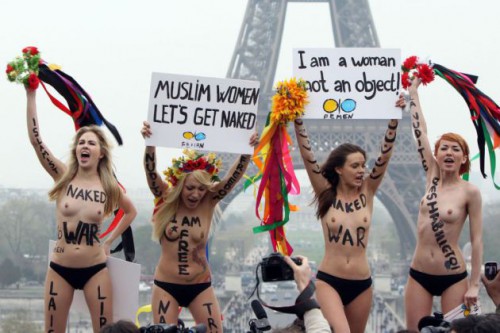




 Voilà plus de quatre ans qu’une nouvelle procédure pour interdire nationalement la culture d’OGM était en discussion. Le 12 juin, un « accord politique » a finalement été trouvé entre les ministres de l’Environnement des 28 États membres de l’Union européenne [
Voilà plus de quatre ans qu’une nouvelle procédure pour interdire nationalement la culture d’OGM était en discussion. Le 12 juin, un « accord politique » a finalement été trouvé entre les ministres de l’Environnement des 28 États membres de l’Union européenne [
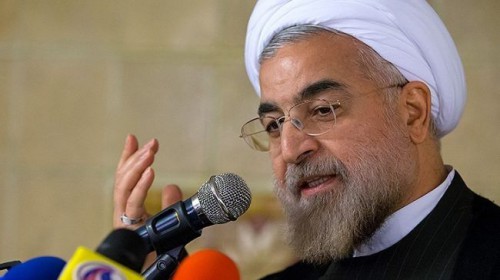




 Voilà de quoi irriter un peu plus les détracteurs du projet de partenariat transatlantique pour le commerce et l’investissement (TTIP), à l’heure où l’opacité des négociations est plus que jamais montrée du doigt. Outre-Rhin, il a suffit d’un tweet pour mettre le feu aux poudres.
Voilà de quoi irriter un peu plus les détracteurs du projet de partenariat transatlantique pour le commerce et l’investissement (TTIP), à l’heure où l’opacité des négociations est plus que jamais montrée du doigt. Outre-Rhin, il a suffit d’un tweet pour mettre le feu aux poudres.